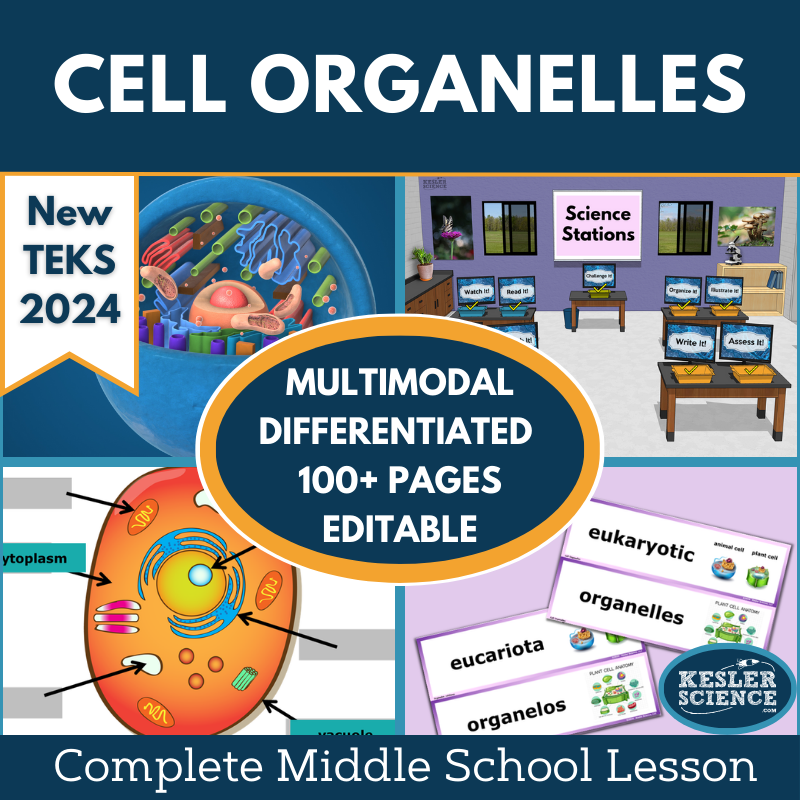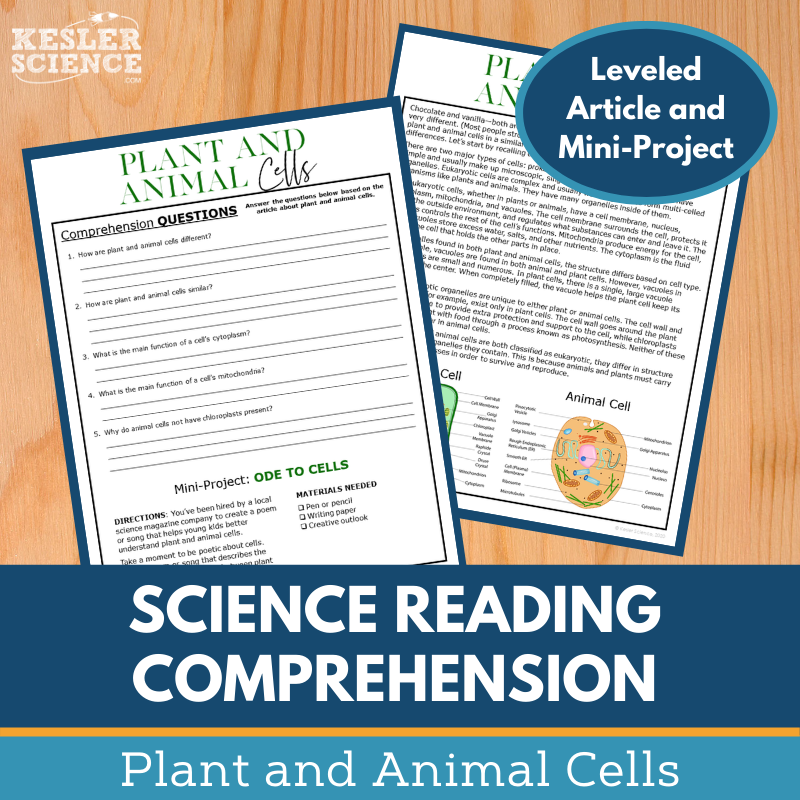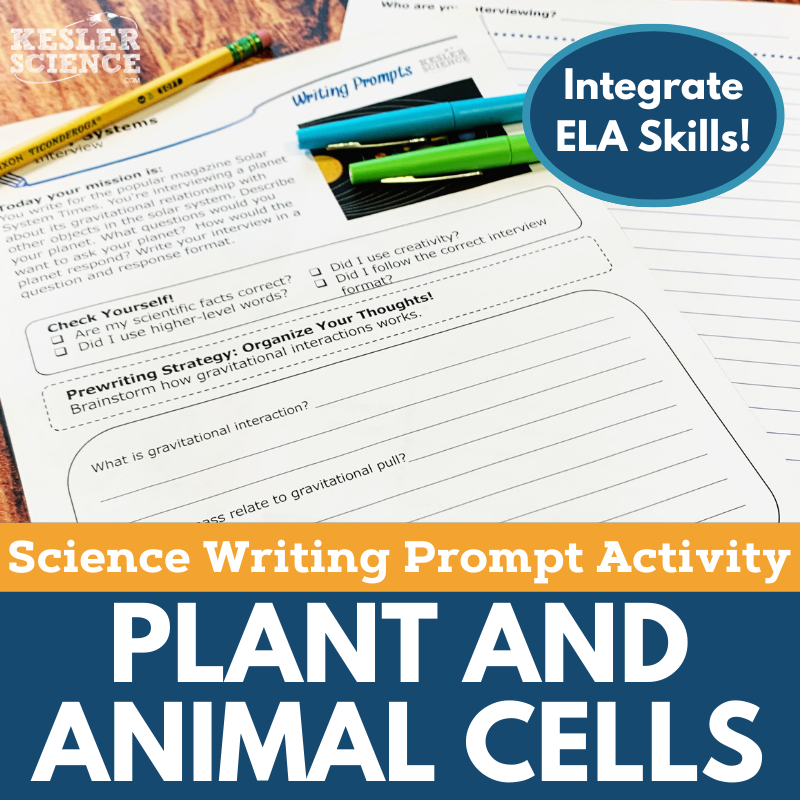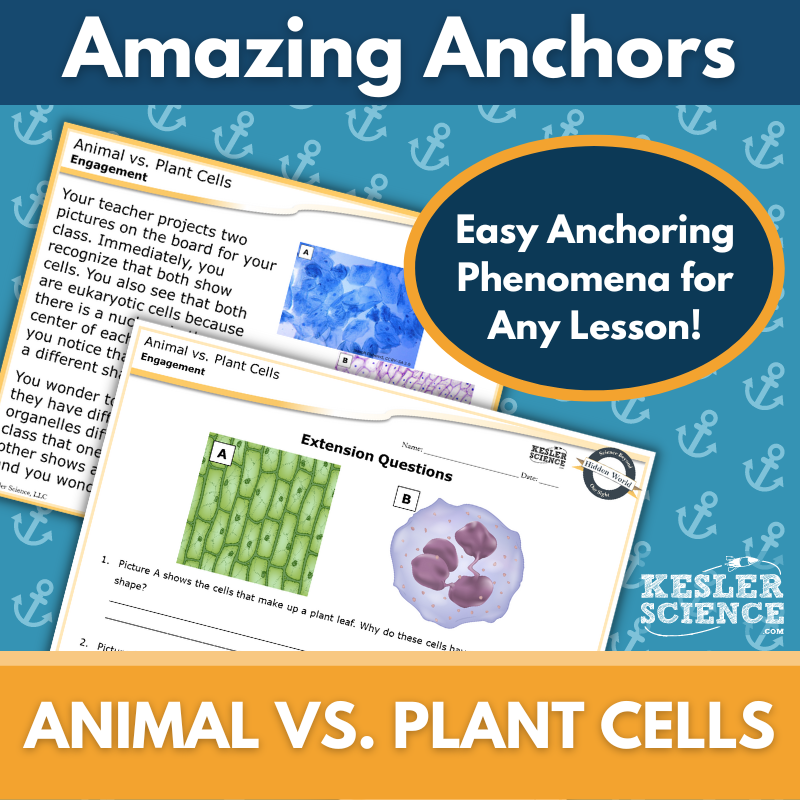Cell Organelles Activities for Middle School Science
Understanding cell organelles and their functions can be challenging for middle school students, but these engaging materials simplify the process! The resources below will give students a comprehensive understanding of cell organelles. All of the following materials are also included in the Kesler Science Membership.
The Kesler Science Cell Organelles Unit is an engaging middle school life science lesson on identifying and describing the functions of organelles in plant and animal cells. It includes editable PowerPoints, worksheets, assessments, and student-choice projects, all designed for differentiated, student-led learning with minimal prep.
Following the 5E Model, the unit provides engagement activities, a hands-on exploration station lab, editable PowerPoints, and interactive notebooks in English and Spanish. Students apply their learning through choice projects and STAAR 2.0-aligned assessments, with flexible digital and printable formats to fit any classroom. Multimodal learning strategies and Spanish translations support all learners.
Aligned with the 2021 TEKS 8.13A standard, this lesson is ideal for in-class or virtual learning. Bundle options offer savings on multiple topics or the complete curriculum, making it a comprehensive resource for teaching cell organelles and their functions in middle school science.
The Kesler Science Cell Organelles Unit is an engaging middle school life science lesson on identifying and describing the functions of organelles in plant and animal cells. It includes editable PowerPoints, worksheets, assessments, and student-choice projects, all designed for differentiated, student-led learning with minimal prep.
Following the 5E Model, the unit provides engagement activities, a hands-on exploration station lab, editable PowerPoints, and interactive notebooks in English and Spanish. Students apply their learning through choice projects and STAAR 2.0-aligned assessments, with flexible digital and printable formats to fit any classroom. Multimodal learning strategies and Spanish translations support all learners.
Aligned with the 2021 TEKS 8.13A standard, this lesson is ideal for in-class or virtual learning. Bundle options offer savings on multiple topics or the complete curriculum, making it a comprehensive resource for teaching cell organelles and their functions in middle school science.
Engage your middle school students with this student-led station lab aligned with the 2021 TEKS 8.13A. Designed for in-class or virtual learning, this lab helps students identify and describe the functions of key organelles, including the cell membrane, nucleus, mitochondria, chloroplasts, and more in plant and animal cells through nine interactive stations featuring videos, readings, research, and hands-on tasks.
Students showcase their understanding by organizing information, illustrating models, writing responses, and completing assessments. A bonus challenge station provides extension activities, and English and Spanish reading passages ensure differentiated instruction.
This low-prep, high-engagement resource encourages active learning and critical thinking. Also available in the Structure of Life Station Lab Bundle, which includes six labs.
Engage your middle school students with this student-led station lab aligned with the 2021 TEKS 8.13A. Designed for in-class or virtual learning, this lab helps students identify and describe the functions of key organelles, including the cell membrane, nucleus, mitochondria, chloroplasts, and more in plant and animal cells through nine interactive stations featuring videos, readings, research, and hands-on tasks.
Students showcase their understanding by organizing information, illustrating models, writing responses, and completing assessments. A bonus challenge station provides extension activities, and English and Spanish reading passages ensure differentiated instruction.
This low-prep, high-engagement resource encourages active learning and critical thinking. Also available in the Structure of Life Station Lab Bundle, which includes six labs.
The Cell Organelles Student Choice Projects align with the 2021 TEKS 8.13A standard, giving middle school students the opportunity to select a project that fits their preferred learning style. A project page outlines six student-led options plus a “design your own” project, with an editable rubric for teacher, peer, or self-assessment. This resource is also part of the Cell Organelles Complete Lesson for TEKS 8.13A.
These engaging, multimodal projects provide students with creative ways to demonstrate their understanding, while teachers can customize the rubric to meet their grading preferences. The flexible structure supports differentiation, ensuring all students can participate successfully.
Projects use standard classroom supplies like paper, markers, and scissors, with several options for digital project completion. Also available in the Structure of Life Bundle (six topics for grades 6-8) and the MEGA Student Choice Project Bundle (84 topics) for grades 6-8.
The Cell Organelles Student Choice Projects align with the 2021 TEKS 8.13A standard, giving middle school students the opportunity to select a project that fits their preferred learning style. A project page outlines six student-led options plus a “design your own” project, with an editable rubric for teacher, peer, or self-assessment. This resource is also part of the Cell Organelles Complete Lesson for TEKS 8.13A.
These engaging, multimodal projects provide students with creative ways to demonstrate their understanding, while teachers can customize the rubric to meet their grading preferences. The flexible structure supports differentiation, ensuring all students can participate successfully.
Projects use standard classroom supplies like paper, markers, and scissors, with several options for digital project completion. Also available in the Structure of Life Bundle (six topics for grades 6-8) and the MEGA Student Choice Project Bundle (84 topics) for grades 6-8.
Students will use household objects to model plant and animal cell organelles, analyzing which items best represent different cell structures. They will compare the two types of cells and discuss how structural differences impact function.
This resource includes three differentiated labs to accommodate all learners. The Dependent Lab offers guided inquiry, the Modified Lab provides additional scaffolding with structured prompts, and the Independent Lab allows students to design and analyze models with minimal guidance. Each lab includes editable teacher resources, answer keys, and CER conclusion questions to reinforce key concepts.
Students will need bubble wrap, zip-close bags, plastic containers, balloons, batteries, and solar calculators to construct their models. The lesson aligns with TEKS and NGSS standards, focusing on differentiating structure and function in plant and animal cells.
Bundle and save! This lab is also available in the Complete Inquiry Labs Bundle, providing hands-on, student-led investigations across multiple life science topics.
Students will use household objects to model plant and animal cell organelles, analyzing which items best represent different cell structures. They will compare the two types of cells and discuss how structural differences impact function.
This resource includes three differentiated labs to accommodate all learners. The Dependent Lab offers guided inquiry, the Modified Lab provides additional scaffolding with structured prompts, and the Independent Lab allows students to design and analyze models with minimal guidance. Each lab includes editable teacher resources, answer keys, and CER conclusion questions to reinforce key concepts.
Students will need bubble wrap, zip-close bags, plastic containers, balloons, batteries, and solar calculators to construct their models. The lesson aligns with TEKS and NGSS standards, focusing on differentiating structure and function in plant and animal cells.
Bundle and save! This lab is also available in the Complete Inquiry Labs Bundle, providing hands-on, student-led investigations across multiple life science topics.
The Cells Escape Room is an interactive challenge that helps students demonstrate their understanding of cells, cell organelles, and their functions in an engaging way. Aligned with TEKS and NGSS standards, this activity reinforces cell theory, organelle functions, and how cells contribute to larger biological systems.
With eight customizable puzzles, teachers can choose which ones to include and in what order, making it adaptable for different class periods. Run it as a simple envelope-based activity or create a more immersive experience using locks and a storage box. A digital version is also included for remote learning via Google Slides or PowerPoint.
Teacher directions, answer keys, digital answer sheets, editable versions, reward templates, and over 50 prize ideas are all included. This low-prep, high-engagement resource makes learning about cells exciting and memorable!
The Cells Escape Room is an interactive challenge that helps students demonstrate their understanding of cells, cell organelles, and their functions in an engaging way. Aligned with TEKS and NGSS standards, this activity reinforces cell theory, organelle functions, and how cells contribute to larger biological systems.
With eight customizable puzzles, teachers can choose which ones to include and in what order, making it adaptable for different class periods. Run it as a simple envelope-based activity or create a more immersive experience using locks and a storage box. A digital version is also included for remote learning via Google Slides or PowerPoint.
Teacher directions, answer keys, digital answer sheets, editable versions, reward templates, and over 50 prize ideas are all included. This low-prep, high-engagement resource makes learning about cells exciting and memorable!
In this engaging lesson, students explore the differences between plant and animal cells by reading a nonfiction article about how organelles contribute to structure and function. They answer comprehension questions and create a poem or song comparing the similarities and differences between cell types. Designed for grades 6-8 (and advanced 5th graders), this resource includes two Lexile-leveled passages (1100-1300) to support science literacy and differentiation.
The lesson features 5-7 comprehension questions, a creative hands-on project, and a Cornell notes template. Eye-catching, printable graphics enhance engagement, and the resource is fully compatible with Google Classroom, MS Teams, Schoology, and Canvas, making it ideal for both in-person and virtual learning. Students can complete all activities directly within the digital document for seamless use.
Perfect for absent students, sub plans, extra credit, or whole-class instruction, this flexible resource reinforces science literacy, critical thinking, and discussion skills. The Science Reading Comprehension Passages Vol. 1 bundle includes 40 additional passages, offering even more opportunities for reading comprehension and analysis.
In this engaging lesson, students explore the differences between plant and animal cells by reading a nonfiction article about how organelles contribute to structure and function. They answer comprehension questions and create a poem or song comparing the similarities and differences between cell types. Designed for grades 6-8 (and advanced 5th graders), this resource includes two Lexile-leveled passages (1100-1300) to support science literacy and differentiation.
The lesson features 5-7 comprehension questions, a creative hands-on project, and a Cornell notes template. Eye-catching, printable graphics enhance engagement, and the resource is fully compatible with Google Classroom, MS Teams, Schoology, and Canvas, making it ideal for both in-person and virtual learning. Students can complete all activities directly within the digital document for seamless use.
Perfect for absent students, sub plans, extra credit, or whole-class instruction, this flexible resource reinforces science literacy, critical thinking, and discussion skills. The Science Reading Comprehension Passages Vol. 1 bundle includes 40 additional passages, offering even more opportunities for reading comprehension and analysis.
The Biodiversity Science Writing Prompt Activity engages middle school students in exploring life science through a call-to-action letter. This activity strengthens science reasoning and writing skills while reinforcing key biodiversity concepts. Designed for in-person and virtual learning, it keeps students actively engaged in and outside the classroom.
Aligned with TEKS, this low-prep resource works well for elaboration, review, or integration with other Kesler Science products. It includes teacher directions, project ideas, rubrics, projection-ready prompts, full-sized handouts, and a digital interactive version compatible with Google Slides or PowerPoint.
This writing activity is ideal for cross-curricular connections, formative assessments, student choice projects, extra credit, early finishers, and differentiation. Students can display their work on a bulletin board or compile them into a class anthology for a lasting collection.
The Science Writing Prompt Activities are available in bundles for Earth Science, Life Science, and Physical Science, as well as a MEGA bundle with all 145 topics. Expand your students’ science literacy and critical thinking with this engaging resource.
The Biodiversity Science Writing Prompt Activity engages middle school students in exploring life science through a call-to-action letter. This activity strengthens science reasoning and writing skills while reinforcing key biodiversity concepts. Designed for in-person and virtual learning, it keeps students actively engaged in and outside the classroom.
Aligned with TEKS, this low-prep resource works well for elaboration, review, or integration with other Kesler Science products. It includes teacher directions, project ideas, rubrics, projection-ready prompts, full-sized handouts, and a digital interactive version compatible with Google Slides or PowerPoint.
This writing activity is ideal for cross-curricular connections, formative assessments, student choice projects, extra credit, early finishers, and differentiation. Students can display their work on a bulletin board or compile them into a class anthology for a lasting collection.
The Science Writing Prompt Activities are available in bundles for Earth Science, Life Science, and Physical Science, as well as a MEGA bundle with all 145 topics. Expand your students’ science literacy and critical thinking with this engaging resource.
These 6th-8th grade formative assessments provide engaging, flexible ways to check student understanding. The Structure of Life Set features 24 WIKI Tickets© assessments in five formats: projection, three printable handouts, and a digital version for Google Slides or PowerPoint. Designed for interactive learning, these assessments fit any classroom setup.
Aligned with NGSS and TEKS standards, WIKI Tickets© cover key life science topics such as cell theory, organelles, heredity, reproduction, the fossil record, and homeostasis. A table of contents ensures easy standard alignment, making it simple to track progress.
WIKI Tickets© (“What I Know Is”) work as exit tickets, bellringers, or quick progress checks. Teachers can project, print, or assign digitally for in-person or virtual learning. These ready-to-use assessments make monitoring student learning simple and effective.
These 6th-8th grade formative assessments provide engaging, flexible ways to check student understanding. The Structure of Life Set features 24 WIKI Tickets© assessments in five formats: projection, three printable handouts, and a digital version for Google Slides or PowerPoint. Designed for interactive learning, these assessments fit any classroom setup.
Aligned with NGSS and TEKS standards, WIKI Tickets© cover key life science topics such as cell theory, organelles, heredity, reproduction, the fossil record, and homeostasis. A table of contents ensures easy standard alignment, making it simple to track progress.
WIKI Tickets© (“What I Know Is”) work as exit tickets, bellringers, or quick progress checks. Teachers can project, print, or assign digitally for in-person or virtual learning. These ready-to-use assessments make monitoring student learning simple and effective.
Lesson Extensions provide student choice activities that engage fast finishers with critical thinking and creative challenges. These extensions offer rigorous yet fun learning opportunities, helping reinforce key life science concepts, fill downtime during testing, and prevent distractions. Designed to deepen students’ understanding of the structure of life, the activities align with NGSS and TEKS standards.
Each extension includes four engaging activities: Puzzler enhances problem-solving skills, Maker Space promotes hands-on STEAM exploration, Tech Connection integrates digital media projects, and Word Master incorporates creative writing. These flexible formats ensure students can engage with content in ways that best suit their learning styles.
This resource includes teacher directions, answer keys, projection slides for easy class display, and printable full- and half-sheet versions for versatile classroom use. Covering topics like cell theory, heredity, natural selection, and body systems, these high-level lesson extensions support independent learners while reinforcing science literacy and critical thinking.
Lesson Extensions provide student choice activities that engage fast finishers with critical thinking and creative challenges. These extensions offer rigorous yet fun learning opportunities, helping reinforce key life science concepts, fill downtime during testing, and prevent distractions. Designed to deepen students’ understanding of the structure of life, the activities align with NGSS and TEKS standards.
Each extension includes four engaging activities: Puzzler enhances problem-solving skills, Maker Space promotes hands-on STEAM exploration, Tech Connection integrates digital media projects, and Word Master incorporates creative writing. These flexible formats ensure students can engage with content in ways that best suit their learning styles.
This resource includes teacher directions, answer keys, projection slides for easy class display, and printable full- and half-sheet versions for versatile classroom use. Covering topics like cell theory, heredity, natural selection, and body systems, these high-level lesson extensions support independent learners while reinforcing science literacy and critical thinking.
This Amazing Anchors lesson offers a no-prep way to introduce plant and animal cells with an engaging, real-world approach. The two-part resource starts with an analysis of two different cell images, guiding students through comprehension and extension questions. The second reading explains the key differences between plant and animal cells in an accessible format, reinforcing learning with follow-up questions.
This resource includes teacher directions, answer keys, projection slides, a digital version for LMS platforms, and printable handouts. Aligned with TEKS, it helps students connect cell structures to their functions, making the topic more relevant and engaging.
Designed for both in-person and digital learning, this lesson is print- and tech-friendly. A modified version with sentence starters and simplified language supports differentiation, ensuring accessibility for all students. Whether used as an introduction or review, this interactive, standards-aligned lesson fosters scientific thinking and comprehension.
This Amazing Anchors lesson offers a no-prep way to introduce plant and animal cells with an engaging, real-world approach. The two-part resource starts with an analysis of two different cell images, guiding students through comprehension and extension questions. The second reading explains the key differences between plant and animal cells in an accessible format, reinforcing learning with follow-up questions.
This resource includes teacher directions, answer keys, projection slides, a digital version for LMS platforms, and printable handouts. Aligned with TEKS, it helps students connect cell structures to their functions, making the topic more relevant and engaging.
Designed for both in-person and digital learning, this lesson is print- and tech-friendly. A modified version with sentence starters and simplified language supports differentiation, ensuring accessibility for all students. Whether used as an introduction or review, this interactive, standards-aligned lesson fosters scientific thinking and comprehension.
Year-Round Resources
These year-round activities will increase your students' understanding of many middle school science topics. All of these activities are also included in the Kesler Science Membership.
Visual Data & Graphing
You're not alone if your students struggle with understanding graphs, charts, and tables. It's a skill that takes an enormous amount of practice. This resource will help students build a strong foundation in analyzing data and creating their own data visualizations.
Bell Ringers and Warm-Ups
These middle school science bell ringers are an excellent way to engage your students as soon as they walk into your classroom. This comprehensive FULL YEAR resource includes everything you need to start off each science class with an interesting warm-up activity.
Review Board Games
Each game board has been carefully designed to keep students engaged. There are 10 different action spaces on each board and dozens of question cards. All of the actions are related to science concepts and keep the students motivated throughout the game.
Each game is ready to play. Simply print out the board and the cards and let the students enjoy reviewing nine different units.
Essential Questions and Standards
Below are the essential questions and standards associated with the lessons and activities included in the atoms unit. This topic is only one of more than 100 middle school science topics included in the Kesler Science Membership.
-
What is the function of organelles in plant and animal cells?
-
How can we identify the different cell organelles, like cell membrane, cell wall, nucleus, ribosomes, cytoplasm, mitochondria, chloroplasts, and vacuoles?
-
TEKS Science - 8.13A Cell Organelles
Kesler Science Membership
Imagine never having to search for another middle school science lesson again. The membership gives you access to ALL of the Kesler Science products in one place (Yes, including everything above).
Say goodbye to long hours of lesson prep.





















